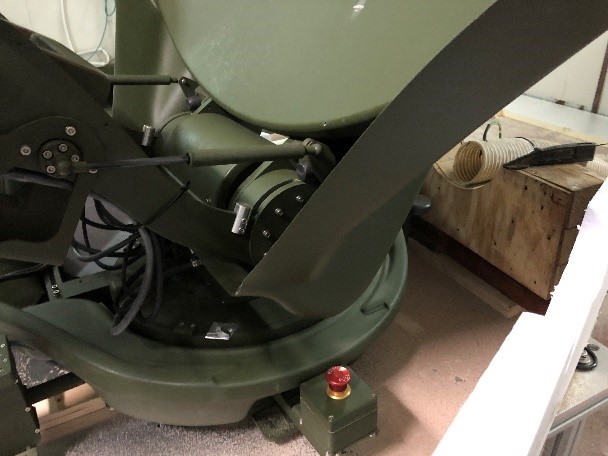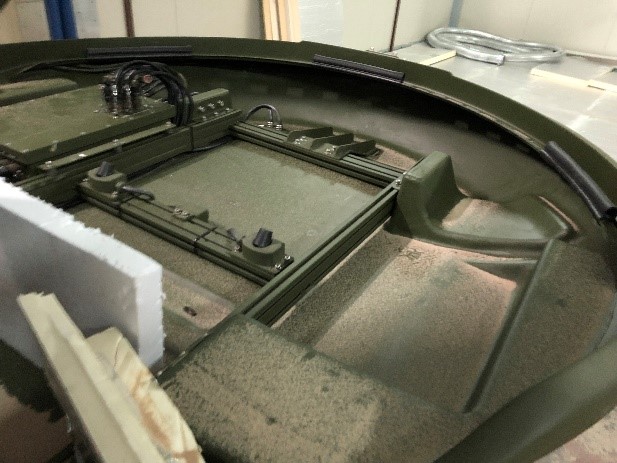- 2022-04-04 15:51:32

We will proceed to elaborate on the “Methods” and “Procedure”s of environmental standards of MIL-STD-810 in our article series. Instead of writing down the obvious information already given in the standard, we will be discussing more practical information on product design, features regarding “Equipment Under Test” (EUT), and conducting tests.
Test Method 510.5 – Sand and Dust
This method is used to evaluate all mechanical, optical, electrical, electronic, electrochemical, and electromechanical devices likely to be exposed to dry blowing sand or blowing dust-laden atmospheres. The blowing sand and dust environment is usually associated with hot-dry regions. It exists seasonally in most other regions. Naturally-occurring sand and dust storms are an important factor in the deployment of materiel, however, the mechanization of military operations generates substantial levels of sand and dust.


Picture: PDA-150-MIL Antenna Motorised Pedestal During Sand Test (Left) and Accumulated Sand From Aftermath Photo of POD Housing
For more info: https://pals.com.tr/product/pda-150-mil
Procedures of this method are as follows:
Procedure I - Blowing Dust. This test is performed to help evaluate the ability of materiel to resist the effects of dust that may obstruct openings, penetrate cracks, crevices, bearings, and joints, and evaluate the effectiveness of filters.
Procedure II - Blowing Sand. This test is performed to help evaluate the ability of materiel to be stored and operated in blowing sand conditions without degrading performance, effectiveness, reliability, and maintainability due to abrasion (erosion) or clogging effects of large, sharp-edged particles.
Tips and Tricks;
• Determine test item configuration with the customer. Use a test item configuration that reproduces, as close as possible, the anticipated material configuration during storage or use, such as:
a. Enclosed in a shipping/storage container or transit case.
b. Protected or unprotected.
c. Deployed realistically or with restraints, such as with openings that are normally covered.
• Determine test temperature with the customer. Generally, conduction of the blowing dust tests with the test item at the high operating or storage temperature obtained from the temperature response of the test item in the high-temperature test (Method 501.5), or the solar radiation test (Method 505.5) applied.
You may want to check our corresponding articles because of the involvement and effects of heat during the test.
https://pals.com.tr/blog/environmental-test-engineering-and-pals-service-article-series-5-mil-std-810g-method-5017-high-temperature
• Determine exposure orientation with the customers. Orient the test item such that the most vulnerable surfaces face the blowing dust. Using the specified test duration, rotate the test item, if required, at equal intervals to expose all vulnerable surfaces. For example: see the PDA-150-MIL photograph given in this article, moving parts of the system (motorized pedestal) chosen for the application, and the test conducted from 4 surfaces.
• Determine test duration with the customer. Conduct blowing dust tests for at least 6 hours at standard ambient temperature, and an additional 6 hours at the high storage or operating temperature. On other hand, Perform blowing sand tests for a minimum of 90 minutes per each vulnerable face. There are stated by the standard.
• Determine operational check procedure. No one can know how to operate a EUT better than its manufacturer. It is usually a summary of features that may be affected by the test. Please keep in mind that these tests may be conducted by a test laboratory expert thus procedure should be written in detail such as if someone who first sees EUT can conduct operational checkout.
• Determination of sealants from the design phase of materiel is highly recommended. Failure of test and correction can cost higher than using a correct sealant in the first place. They might seem to cost more but imagine the cost of calling your devices from the field back to correct the failure.
• There are enclosure filters against sand and dust in the market. Imagine a gasket made out of steel wool or such conductive material. And it is fused with a silicone gasket material for temperature and rain isolation. Consider EUT lifecycle events and deployment conditions while choosing.
• Sand and dust effects on moving parts. Especially if moving parts are exposed. Design moving parts in the enclosure and use proper sealant.
• If not sand and dust may cake on lubricants if exposed. Consider adding brushes on the edges of moving parts. Even this simple solution will dramatically reduce the sand and dust exposure.
DID YOU KNOW?
PALS Electronics has experts on all subjects of test engineering, mechanical or electronic design, environmental condition engineer, system engineer, etc. PALS provides consulting, training, tailoring, test plan, test engineering, test services in all phases of your project. Please feel free if you have any questions or inquiries from https://pals.com.tr/contact










